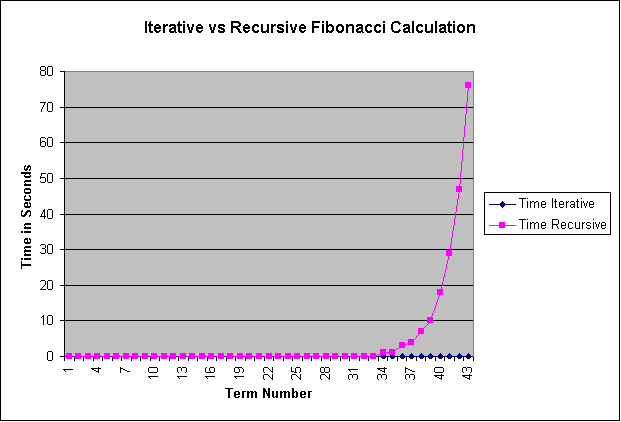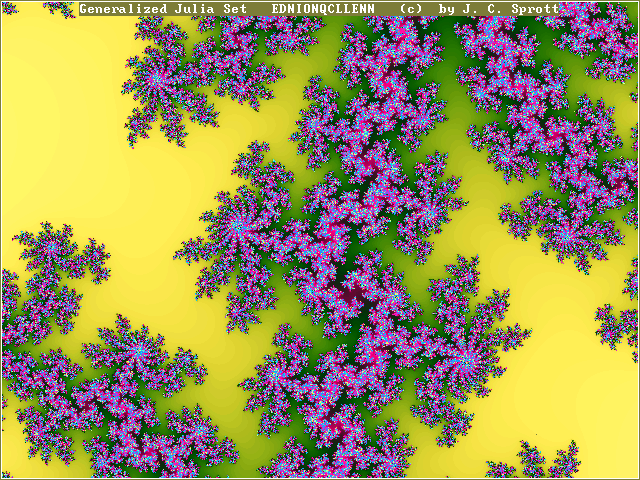Recursion
This page last updated October 19, 2003
This lecture is
located at http://geocities.datacellar.net/BillAlexander/recursion_lecture.html
Definition
Recursion
is a process or function defined in terms of itself.
re·cur·sion n.: See Recursion.
Example 1: Factorial
A
simple mathematical example of recursion is the factorial.
A
factorial is generally defined as:
n! = n * (n-1) * (n-2) * … * 2 * 1
Or
in recursive terms:
n! = n * (n-1)!
where n > 0 and 1! = 1
C++ Factorial Example (see http://geocities.datacellar.net/BillAlexander/Factorial.cpp)
In
C++, we could define the factorial class as follows:
class Factorial
{
public:
unsigned
int Iterative (unsigned int n);
unsigned
int Recursive (unsigned int n);
};
In
the Factorial class, I have defined the two member functions: Iterative( ) and Recursive ( ).
Factorial::Iterative(
) performs an iterative calculation of the factorial.
It is defined as follows:
unsigned int Factorial::Iterative (unsigned
int n)
{
int
ret;
int
i;
// Check for 0
if
(n ==
0)
return 1;
// Initialize return value to n
ret
= n;
// Calculate the factorial
for
(i=n-1; i>1; i--)
{
ret
*= i;
}
return
ret;
}
Factorial::Iterative(
) takes the parameter n and calculates n * (n-1) * (n-2) * … * 2 * 1. It is a very simple function.
The
Factorial::Recursive( ) member function, on the other hand, calculates
the
factorial in the recursive manner:
unsigned int Factorial::Recursive (unsigned
int n)
{
// Are we at the end of the recursive factorial?
if
(n
<= 1)
{
// Yes -- terminate the calculation
return 1;
}
else
{
// No -- continue recursive calculation
return n * Recursive (n-1);
}
}
Factorial::Recursive(
) takes the parameter n can calculates n * (n-1)! This
also is a very simple function.
The
reason I have defined both an iterative and recursive function is to
demonstrate the differences between the two processes.
Both functions are simple, but the
Factorial::Recursive( ) is simpler
and easier to understand.
This is one of the great strengths of recursion.
Example 2: The Fibonacci Sequence
A
second mathematical example of recursion is the Fibonacci sequence:
1 1 2 3 5 8 13 21 34 55 …
Or
F(n) = 1 for n <= 2
F(n-2) +
F(n-1) for n > 2
This
is more complex than the factorial, but demonstrates both the strengths
and
weaknesses of recursion.
C++ Fibonacci Example (see http://geocities.datacellar.net/BillAlexander/Fibonacci.cpp)
In
C++, we could define the Fibonacci class as follows:
class Fibonacci
{
public:
unsigned
int Iterative (unsigned int n);
unsigned
int Recursive (unsigned int n);
};
Just
as with the factorial example, I have defined the two member functions
Iterative( ) and Recursive ( ):
unsigned int Fibonacci::Iterative (unsigned
int n)
{
unsigned
int i;
unsigned
int n_minus_2; // value of n-2 term
unsigned
int n_minus_1; // value of n-1 term
unsigned
int nth;
// value nth term
// Check for 1st 2 terms
if
(n
<= 2)
return 1;
// Calculate the Fibonacci nth term
n_minus_2
= 1;
n_minus_1
= 1;
for
(i=2;
i<n; i++)
{
// The value of the nth term is the
value of n-2 term + value
of n-1 term
nth =
n_minus_2 + n_minus_1;
// Update n-2 and n-1 terms for next
term calculation
n_minus_2 = n_minus_1;
n_minus_1 = nth;
}
// Return the nth term calculation
return
nth;
}
unsigned int Fibonacci::Recursive (unsigned
int n)
{
// Are we at the end of the recursive Fibonacci?
if
(n
<= 2)
{
// Yes -- terminate the calculation
return 1;
}
else
{
// No -- continue recursive calculation
return Recursive(n-2) + Recursive(n-1);
}
}
As with
the factorial example, the Recursive( ) member function is simpler , easier
to understand
, elegant and beautiful. However,
the Fibonacci example also reveals
the dark side to recursion: inefficient use of system resources.
System Resource Comparison Between Fibonacci::Iterative( ) and Fibonacci::Recursive( )
What
I mean by “system resources” in this lecture is:
CPU usage
Memory usage (stack, heap, etc)
Let’s
start with CPU usage. If we execute
Fibonacci::Iterative(43) and Fibonacci::Recursive(43), we will
immediately
notice that the recursive method takes much longer to execute. On my 1.6 GHz laptop,
Fibonacci::Iterative(43) executes in a blink of an eye, whereas,
Fibonacci::Recursive(43) takes a whopping 76
seconds! Below is a graph of
various values used for
both the iterative and recursive methods (see http://geocities.datacellar.net/BillAlexander/fib_calc.html):

One
reason for the inefficiency of Fibonacci::Recursive( ) is that many
operations
are repeated. We can see these repeated
operations by examining the recursion tree of Fibonacci::Recursion(6):
In
the above diagram, we abbreviate Fibonacci::Recursive(n) as F(n). With F(6), we see that F(1) is called 3
times, F(2) is called 5 times, F(3) is called 3 times, F(4) is called 2
times
and F(5) is called once. For very large
values of n, the repeated function calls are so numerous, that the
calculation
is doing mostly repeated work. Thus,
you should use the iterative version of the Fibonacci calculator for a
truly
useful application.
Another
consideration with recursion is the depth in which the calculation
traverses on
the stack. A stack is a special piece
memory used by a program to store the function parameters, function
return
addresses and function local variables.
As a recursive calculation descends to further levels, more and
more
memory is required. If a recursive
function is not written carefully, it can crash an application’s stack
and
generate a protection fault in the system.
The
above Fibonacci recursion tree shows that F(6) recurses down 4 levels. In general, F(n) will recurse down n-2
levels. For example, F(100) will
recurse down 98 levels! This is
probably not cause a problem on our standard PCs today, but certain
applications may have trouble. Embedded
systems, for example, generally have a limited amount of memory and
recursing
down 98 levels may cause a protection fault.
The
inefficient use of system resources in the Fibonacci example does not
mean that
all recursion is inefficient. You must
think about the algorithm and how it affects the system.
A
solution to resource inefficiency is to use an optimizing compiler
which
detects recursion and generate iterative code instead.
This has the advantage of being both elegant
and efficient (see http://www.csi.uottawa.ca/~holte/T26/efficient-rec.html).
Another
solution to the inefficiency problem is stackless recursion (see
http://www.olympus.net/personal/7seas/recurse.cpp,
Stackless Factorial).
Basically, you write the function so that
you limit the amount of recursion that occurs.
General Recursion Programming Rules:
Rule1:
Always make sure to terminate the
recursion. This is often referred to as
the “Base Case”.
Example
of what not to do:
int Fibonacci::Recursive (int n)
{
return
Recursive (n-2) + Recursive (n-1);
}
This
will never end because there is no base case to terminate the
calculation.
Rule
2: Always subdivide the recursion into
smaller pieces. This leads to the base
case and thus will terminate the recusion.
Example:
double Bigger::Recursion (double n)
{
if (n == 0.0)
return 1.0
else
return Recursion (n + 1.0);
}
This
will never end because n is always increasing away from the base case. A stack fault will eventually occur.
Example:
int
Forever::Recusrion (int n)
{
if (n == 0)
return 1;
else if (n == 1)
return Recursion (1);
else
return Recursion (n-1);
}
Recursion Uses:
Mathematics
Factorial
Fibonacci
Sorting
QuickSort (see http://www.cs.jmu.edu/common/coursedocs/cs240S02/cpp/testSorts/Sorts.cpp)
Bubble Sort
Data
Structures
List Searching
Tree Searching
Binary Tree (see http://www.cs.jmu.edu/common/coursedocs/cs240S02/cpp/testSorts/BinarySearchTree.cpp)
B-Tree
Data
Processing
Databases
Language
and syntax parsing
Compilers
Complex
problems
Towers of Hanoi (see http://kedem.cs.duke.edu/cps104/Homework/Homework03.pdf)
Graphics


Other References
http://www.cs.jmu.edu/common/coursedocs/cs240S02/SrcCode.html
http://www2.hig.no/~algmet/animate.html
http://babbage.clarku.edu/~djoyce/julia/ztemp/
http://www.olympus.net/personal/7seas/recurse.cpp
http://www.dcs.bbk.ac.uk/~roger/cpp/week16.htm
http://www.dcs.bbk.ac.uk/~roger/cpp/week17.htm
http://www.doc.ic.ac.uk/~wjk/C++Intro/RobMillerL8.html